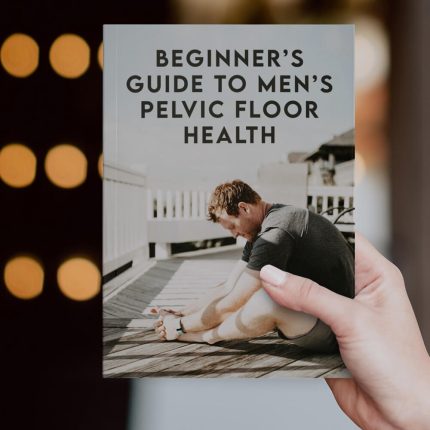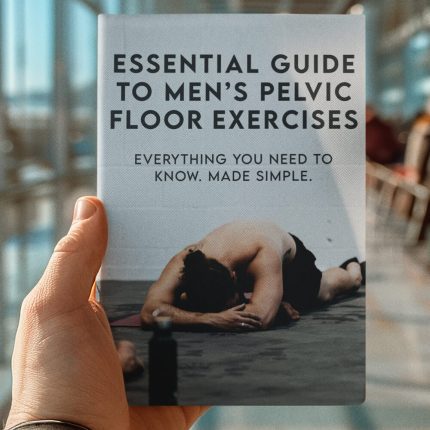
Pelvic Floor Therapy
Biofeedback Pelvic Floor Men

Ever wondered if you could hack your own pelvic health like you hack your social media trends? Biofeedback Pelvic Floor for Men isn’t just a buzzword, it’s a game-changing approach blending cutting-edge technology with old-school self-care to boost your manhood’s powerhouse. Whether you’re a gym rat, a desk jockey, or just curious about optimizing your core strength, this guide is your new go-to resource for all things pelvic floor. Get ready to dive deep into biofeedback mechanisms, pelvic floor exercises, lifestyle tweaks, and holistic strategies that put control back in your hands (or well, where it counts!).
Quick Links to Useful Sections
- Biofeedback Pelvic Floor Therapy for Men: An Introduction
- Why Pelvic Floor Health Matters for Men
- The Science Behind Biofeedback: How Technology Empowers Your Pelvic Health
- Biofeedback in Action: Techniques and Tools for Men
- Digital Biofeedback Devices
- Integrated Mobile Apps
- Guided Exercise Protocols
- Pelvic Floor Exercises: Building Your Core Foundation
- The Role of Nutrition, Hydration, and Lifestyle in Pelvic Floor Health
- Mind-Body Connection: Harnessing Mental Focus for Physical Gains
- Integrative Approaches: Merging Conventional Therapy with Biofeedback
- Real-Life Success Stories: Transforming Men’s Pelvic Health
- Resources and Community Support: Your Next Steps
- Frequently Asked Questions About Biofeedback Pelvic Floor Therapy for Men
- Your Journey to Empowered Pelvic Health
Biofeedback Pelvic Floor Therapy for Men: An Introduction
Biofeedback pelvic floor therapy isn’t just for women, it’s a secret weapon for men striving to improve their pelvic health, manage incontinence, enhance sexual performance, and prevent injury. In simple terms, biofeedback uses state-of-the-art devices to monitor pelvic muscle activity in real time. With the help of sensors and digital displays, you can visually track your progress as you learn to strengthen or relax your muscles. It’s like having a personalized coach in your pocket, guiding you to success one contraction at a time.
For men, pelvic floor issues can often be overlooked or misunderstood. Many assume that pelvic floor health is a female-only domain. However, the male pelvic floor supports critical functions such as bladder and bowel control and plays a significant role in sexual health. When pelvic floor muscles are too tight, too weak, or uncoordinated, issues like urinary incontinence, erectile dysfunction, and chronic pelvic pain can surface. Biofeedback offers clear, data-driven insights into these muscle actions, enabling you to retrain your body using scientifically backed methodologies.
The beauty of biofeedback therapy is its non-invasive nature. No needles or medications, just high-tech sensors and your willingness to learn your body’s language. With regular practice, patients can experience noticeable improvements in strength, coordination, and overall pelvic function. In a world where self-improvement is the norm, why not extend that mantra to your pelvic floor?
Why Pelvic Floor Health Matters for Men
Let’s break the taboo: pelvic floor health is essential for every man. Your pelvic floor muscles are responsible for supporting your bladder, bowel, and even sexual function. They are the unsung heroes that play a vital role in everyday actions from sitting and lifting to, well, your intimate moments. Ignoring them can lead to a cascade of issues, including urinary incontinence, pelvic pain, and decreased sexual satisfaction.
Young and old alike can face pelvic floor dysfunction, whether it’s because of high-impact sports, sedentary lifestyles, or post-surgical recovery. Gen Z and millennial men are especially prone to the pitfalls of desk-bound lifestyles, where long hours of sitting lead to tight hip flexors, weakened pelvic muscles, and an imbalance in core stability. Biofeedback is a modern solution designed for our fast-paced, tech-savvy generation, ensuring that you maintain an optimized balance between work, play, and health.
Beyond its physical benefits, focusing on your pelvic floor can also be a confidence booster. When you understand and control this region of your body, you gain a renewed sense of empowerment that spills over into every aspect of your life. It’s about reclaiming your body, staying proactive with your health, and proving that real strength isn’t just about biceps or abs, it’s about a resilient, well-functioning core from the inside out.
The Science Behind Biofeedback: How Technology Empowers Your Pelvic Health
If you’re the type who geeks out on gadgets and data, biofeedback pelvic floor therapy is right up your alley. At its core, biofeedback uses electrical sensors to detect and measure the muscle activity in your pelvic region. This information is then transmitted to a display, giving you real-time feedback on muscle contractions. It’s the perfect fusion of medical science and modern technology, tailored to help you fine-tune your pelvic workouts.
The mechanism is surprisingly intuitive. Tiny electrodes are carefully placed on your body near the muscle groups in question. As you perform specific exercises, like contractions or relaxations, the sensors pick up electrical impulses generated by muscle actions. Graphs, numerical readings, and sometimes even animations on a screen show you exactly how hard you’re working or if you need to engage different muscles. This immediate visual feedback can demystify the often-hidden pelvic floor, making each training session more productive.
Moreover, biofeedback isn’t just about numbers, it cultivates self-awareness. Many men are shocked to learn how little they actually know about activating their pelvic muscles. By watching real-time data, you can better understand the nuances of your body’s performance. Over time, you’ll be able to tune into those subtle signals without technical assistance, creating a more mindful, effective approach to your pelvic floor exercises. This science-backed method transforms pelvic training from guesswork into a personalized, precisely calibrated workout plan.
Biofeedback in Action: Techniques and Tools for Men
Implementing biofeedback in your pelvic floor regimen doesn’t require a PhD in physiology, just a willingness to learn about your own body. Let’s break down some of the popular techniques and tools that can be incorporated into your routine.
Digital Biofeedback Devices
Modern biofeedback devices vary from wearable sensors that connect to your smartphone to specialized kits available at pelvic health clinics. These devices track your pelvic muscle contractions, presenting data in easy-to-read formats that even a technophile novice can understand. They are designed with user-friendliness in mind, ensuring that your journey towards better pelvic health feels more like playing a high-tech video game than a daunting medical procedure.
Integrated Mobile Apps
Imagine having a personal trainer in your pocket. Several apps now integrate biofeedback technology with workout routines customized for pelvic floor strengthening. These apps utilize gamification, think scores, progress bars, and achievement badges, to keep you motivated. Whether you’re squeezing during a commercial break or deep in a workout session, these apps guide you through each exercise with a friendly push and real-time performance stats.
Guided Exercise Protocols
Traditional pelvic floor exercises like Kegels are now being upgraded with biofeedback. Men are learning to perform precise contractions while monitoring muscle response, a practice that not only improves strength but also prevents you from overworking adjacent muscles. With guided protocols, you get a roadmap to success, ensuring that every squeeze is strategic and every session effective.
Integrating these cutting-edge tools into your exercise routine transforms pelvic floor training from a hit-or-miss routine into a structured and measurable practice. Embrace the tech-assisted revolution and let biofeedback elevate your pelvic health to new heights.
EXPLORE OUR EXPERT MEN'S PELVIC FLOOR GUIDES WITH HIDDEN TIPS AND TRICKS
👨💻 Men's Pelvic Floor Book Store (Instant Download) 👨💻
Pelvic Floor Exercises: Building Your Core Foundation
You might be wondering, “What exactly should I be doing to strengthen my pelvic floor?” The answer lies in building a practical, consistent exercise routine. Pelvic floor exercises for men are designed to increase the strength, coordination, and endurance of the muscles supporting your bladder, bowel, and sexual function.
The classic Kegel exercise isn’t just for women, men can benefit immensely from them too. The goal is to contract and relax the pelvic muscles deliberately. Start by identifying the correct muscles. One common method is to attempt to stop the flow of urine midstream (not as a regular practice, but just to locate the muscles). Once you’ve identified the muscles, practice contracting for a count of five, then relaxing for five. With biofeedback technology, you can visually confirm that you’re engaging the right muscle groups and doing it effectively.
In addition to Kegels, consider variations like reverse Kegels, which focus on the relaxation phase and help release any undue tension. Combining these exercises with core and glute work can also provide comprehensive support to your pelvic region. As you progress, incorporating more complex routines like bridges or stability ball exercises will add variety and keep your routine engaging.
Remember, consistency is crucial. Much like building a following on social media, steady progress over time yields incredible results. Leverage your biofeedback device as your personal accountability partner and track your improvements with each session. Soon, your pelvic floor will be so finely tuned that everyday activities will feel effortless.
The Role of Nutrition, Hydration, and Lifestyle in Pelvic Floor Health
While targeted exercises and biofeedback devices work wonders on muscle strength, true pelvic floor health is also about what you feed your body and how you live your day-to-day life. Think of it as a holistic cocktail, where diet, hydration, stress management, and sleep all blend together to optimize your physical and mental well-being.
A nutrient-dense diet plays a pivotal role in muscle repair and inflammation reduction. Men should focus on consuming lean proteins such as chicken, fish, and plant-based options like beans and tofu, which are essential for muscle recovery and growth. Incorporate plenty of colorful fruits and vegetables, rich in antioxidants and anti-inflammatory compounds that support tissue healing.
Hydration is another often-overlooked factor. Drinking sufficient water helps maintain muscle elasticity and supports overall tissue health. If you’re hitting the gym hard or simply navigating a busy day at work, stay accountable by keeping a water bottle nearby. Additionally, reducing your intake of processed foods and high-sugar items can significantly diminish inflammation levels, paving the way for smoother pelvic function.
Lastly, stress management and adequate sleep are your secret weapons. Chronic stress can tighten your pelvic floor muscles, counteracting the benefits of your workout routine. Incorporating mindfulness techniques, such as meditation or deep breathing exercises, can help ease that tension. Meanwhile, quality sleep, ideally 7-9 hours per night, ensures your body has sufficient time to rest and repair. Together, these lifestyle adjustments create a supportive framework that enhances the benefits of your biofeedback-enhanced training.
Mind-Body Connection: Harnessing Mental Focus for Physical Gains
It’s no secret that a strong mind leads to a strong body. The connection between mental focus and physical performance is especially true for pelvic floor therapy. When you’re consciously aware of your muscle movements, guided by real-time biofeedback, your brain learns to coordinate fine motor control with precision. This enhanced awareness is key to mastering pelvic floor exercises.
Engaging in mind-body practices such as yoga, Pilates, or mindful meditation can amplify your training results. These practices emphasize purposeful movement and deep breathing, which not only relax tight muscles but also promote optimal circulation in the pelvic region. Think of it as a two-in-one deal, the combination of biofeedback technology and mindful practice helps you channel your inner focus, making each exercise more effective.
If you’re someone who juggles work, social life, and digital distractions, building a mind-body connection can be your secret sauce to consistently effective workouts. Dedicating just a few minutes a day to meditation or focused breathing can clear the mental clutter, ensuring that every contraction during your pelvic floor exercises is intentional and beneficial. This synergy between mental clarity and physical activity is not just a trend, it’s a scientifically supported strategy for enhancing both performance and overall well-being.
Integrative Approaches: Merging Conventional Therapy with Biofeedback
For many men, the journey through pelvic floor health begins with conventional physical therapy. But why limit yourself to just one approach when you can combine the best of both worlds? Integrative pelvic floor therapy for men leverages both traditional methods, like manual therapy and guided exercises, and modern biofeedback technology for an all-encompassing solution.
Imagine working with a seasoned physical therapist who guides you through hands-on techniques, ensuring your pelvic muscles regain strength and mobility. Now add the precision of a biofeedback device that monitors your progress in real time. This dual strategy provides a tangible, measurable path to improvement. Manual therapy can help alleviate tightness and pain, while biofeedback ensures that your exercises are effective and correctly executed.
This integrative method is particularly useful for men recovering from surgeries, athletes looking for performance enhancements, or those dealing with chronic pelvic pain. By combining discipline, technology, and expert guidance, you create an environment where every session leads to improved muscle coordination and better overall pelvic function. It’s not just about working harder, it’s about working smarter with a technique that evolves with your progress.
EXPLORE OUR EXPERT MEN'S PELVIC FLOOR GUIDES WITH HIDDEN TIPS AND TRICKS
👨💻 Men's Pelvic Floor Book Store (Instant Download) 👨💻
Real-Life Success Stories: Transforming Men’s Pelvic Health
Sometimes the best motivation is hearing about real-life transformations. Consider Mark, a 38-year-old software developer who had been experiencing intermittent urinary leakage and lower back discomfort. Initially skeptical about pelvic floor therapy for men, Mark decided to commit to a program that combined biofeedback with traditional exercises and mindfulness training. Over the course of several months, he was able to track measurable improvements in muscle coordination and strength. His confidence soared, both on and off the job.
Then there’s Alex, an avid cyclist in his late 40s, whose high-intensity rides began to take a toll on his pelvic muscles. With the help of a personalized biofeedback regimen, Alex learned to engage the right muscles during his rides and off-season recovery. The result? A reduction in pelvic pain and an overall boost in performance. His story is a testament to how modern technology combined with a holistic approach can lead to remarkable improvements in everyday life.
And let’s not forget Jordan, a young professional navigating the stress of a bustling city life. Jordan found that integrating biofeedback-guided pelvic exercises into a routine that included yoga and a balanced diet not only improved his pelvic floor function but also helped him manage stress levels more effectively. His progress underlines the transformative power of taking control of your pelvic health with a multifaceted, personalized approach.
Resources and Community Support: Your Next Steps
Embarking on a journey to optimize your pelvic floor health can feel like navigating uncharted territory, but you’re not alone. The internet is brimming with forums, communities, and expert resources dedicated to men’s pelvic health. Whether you’re searching for specialist advice, sharing workout accomplishments, or simply looking for inspiration, connecting with like-minded individuals can propel your progress.
Consider joining online communities on platforms like Reddit, Facebook, or dedicated health forums where men exchange success stories, discuss challenges, and share tips on biofeedback techniques and pelvic floor exercises. Many of these groups invite both professionals and enthusiasts, providing a well-rounded perspective on what works best in different scenarios.
Additionally, don’t hesitate to schedule consultations with pelvic health specialists who incorporate biofeedback technology into their practice. With the proper guidance, you can build a tailored program suited to your unique needs and lifestyle. Remember, the journey to improved pelvic health isn’t a lone trek, it’s a community effort filled with support, education, and empowerment.
Your next step? Embrace the available resources, invest in the right biofeedback tools, and tap into the collective knowledge of those who have already transformed their lives. Every shared tip, every success story, and every expert recommendation brings you one step closer to a healthier, more resilient pelvic floor.
EXPLORE OUR EXPERT MEN'S PELVIC FLOOR GUIDES WITH HIDDEN TIPS AND TRICKS
👨💻 Men's Pelvic Floor Book Store (Instant Download) 👨💻
Frequently Asked Questions About Biofeedback Pelvic Floor Therapy for Men
Navigate through some of the most common questions regarding biofeedback pelvic floor therapy for men. We’re here to clear up any confusion and offer guidance to keep your journey on track.
1. What exactly is biofeedback pelvic floor therapy for men?
It’s a non-invasive technique that uses sensors to monitor pelvic muscle activity in real time. This technology helps you identify, train, and control your pelvic floor muscles effectively, which can improve issues like urinary incontinence and sexual performance.
2. Who can benefit from this type of therapy?
Men of all ages can benefit, especially those dealing with pelvic pain, post-surgical recovery, incontinence, or even athletes looking to improve core and pelvic stability.
3. How does the technology work?
Biofeedback devices use electrodes to detect electrical impulses generated by pelvic muscles. The data is then displayed in real time on a screen, giving you immediate insight into your muscle activity so you can adjust your exercises accordingly.
4. Are pelvic floor exercises the same for men and women?
While the basic principles, like contracting and relaxing muscles, are similar, the physical anatomy and targeted muscle groups differ slightly. Men benefit from exercises like Kegels, reverse Kegels, and specific core stabilization routines adjusted for male anatomy.
5. How long does it take to see improvements?
Results vary from person to person, but many men notice improvements within a couple of months when they consistently practice and incorporate biofeedback technology into their routine.
6. Do I need professional supervision?
While many biofeedback devices are designed for at-home use, consulting with a pelvic health specialist can provide personalized guidance and a tailored exercise plan to ensure optimal results.
7. Can biofeedback help with sexual performance?
Yes, enhancing pelvic floor strength and control through biofeedback can lead to improved sexual performance and better overall pelvic function.
8. Is this therapy covered by insurance?
Coverage varies by insurer and region. It’s advisable to check with your healthcare provider or insurance company to determine if biofeedback pelvic floor therapy is covered under your plan.
9. Can I use biofeedback devices alongside other treatments?
Absolutely. Biofeedback is often integrated with traditional physical therapy, lifestyle modifications, and even complementary treatments for a comprehensive approach to pelvic health.
10. How do I choose the right biofeedback device for my needs?
Look for devices that are user-friendly, have positive reviews, and offer clear guidance or integration with mobile apps. Consultation with a healthcare professional can also help you select the device that best suits your needs.
Your Journey to Empowered Pelvic Health
Mastering your pelvic floor isn’t just about fixing a problem, it’s about embracing a holistic journey that bridges health, technology, and a forward-thinking lifestyle. Whether you’re training with biofeedback devices, practicing targeted exercises, or absorbing lifestyle tips to counter stress, every step you take is a step toward empowered, resilient health.
As you integrate these practices into your daily routine, remember that true progress comes from consistency, patience, and self-awareness. Your pelvic floor is a hidden powerhouse that deserves just as much attention as any other part of your body. Embracing biofeedback and integrative therapy means tuning into your body’s signals and responding with smart, effective strategies.
In a world where innovation drives every aspect of our lives, why not apply that same energy to your pelvic health? Equip yourself with the knowledge, tools, and community support needed to transform discomfort into empowerment. Your journey is uniquely yours, curate your plan, celebrate every win, and watch as your overall well-being transforms from the inside out.
Whether you’re a tech-savvy professional or simply someone eager to live your best life, the future of men’s pelvic health is bright. Step boldly into this new era of self-care, let biofeedback be your guide, and discover a world where every part of you thrives, because a healthy pelvic floor is the foundation of a healthy, confident life.
Curious About Your Pelvic Floor? Explore our curated collection of insightful articles to learn more and take charge of your health.
- Pelvic Floor Basics
- Pelvic Floor Exercises & Workouts
- Pelvic Floor Kegel Exercises: Techniques & Benefits
- Advanced Pelvic Floor Workouts
- Pre/Post-Natal Pelvic Floor Routines
- Pelvic Floor Exercises for Men
- Pelvic Floor Therapy Techniques
- At-home vs Professional Pelvic Floor Therapy Options
- Diet & Lifestyle for a Healthy Pelvic Floor
- Pelvic Floor Health & Wellness
- Specialized Pelvic Floor Conditions & Treatments
Now back to the main article!

















